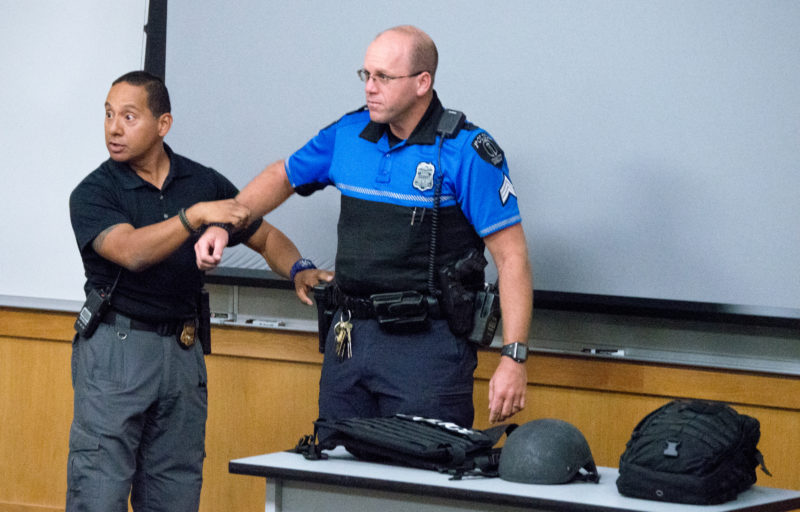Pete Perez Jr., assistant chief of Trinity University Police Department (TUPD), led a presentation on how to respond to active shooters. The presentation was for TUPD officers and took place on Oct. 18. It aimed to prepare the officers for an extreme situation.
In the presentation, the sound of gunfire taken from a recording of a first responder drill was used to demonstrate the consequences of gun violence. For the past few years TUPD has held similar presentations in hopes of making the Trinity campus a more well-informed and safer place.
“The whole point of this presentation is to create a survival mindset. There’s options, there’s choices you’re going to have to make, and the whole point is to stay alive. We’re not trying to scare you, not trying to make you paranoid, but we do want to give you that awareness of your surroundings,” Perez said. “The tools we are giving you are not only for when you are here at Trinity. You can be at HEB, the library, the movies, it can happen anywhere. So these little tips we are going to go through will really give you a lot of options of things to do during a “” heaven forbid “” an incident here on Trinity University campus.”
The shooting at Texas Tech University on Oct. 9 exemplifies the prevalence of active shooter incidents in the U.S and on college campuses. TUPD is taking many precautions in order to prevent and be prepared for an active shooter situation and to respond accordingly if one were to take place.
“We go over our training monthly. We attend national conferences over active shooters. There are just so many incidents over the country we have to be prepared,” Perez said. “We are doing the extra training, we are doing the extra layers. The hardest part is just getting the word out.”
In his presentation, Perez mentioned that current TUPD policy has developed over the years and has been heavily influenced by the shooting at Columbine High School on April 20, 1999. TUPD emphasizes that time is of the essence for both the first responders and the victims. TUPD relies on those on site of an incident to call (210) 999-7000 and help inform them of the situation. This helps TUPD act as effectively and quickly as possible.
“If you make a call on an incident, we need you to give us as much info as you possibly can, so that our officers can respond. … We need something for an officer to respond to. We can’t get that until you call us, and let us know where to go,” said Perez. “We no longer wait for SWAT; we no longer wait for SAPD. Our own officers here will respond to the incident. Time is of the essence. Every second counts. We want to make sure we get to that killing and stop it.”
Perez, joined by John Santellan, sergeant investigator, and Larry Cox, corporal and community awareness liaison, detailed what individuals should expect in an active shooter situation and how to react. Depending on the location and situation, TUPD asks that individuals stay calm and either escape, hide, or if absolutely necessary, take down the shooter. There are many variables in every situation that will determine what course of action is best for those involved.
“Y’all are here, and y’all are already training yourself to have that mindset for survival. This is critical info to take back to your coworkers, your students and anybody you know here on campus,” Cox said.
Active shooters are a threat that affects the national and local community. TUPD is focusing on getting the entire community to be aware of how to deal with such a situation. Debra Chick, administrative assistant for the communications department, attended the seminar.
“I came last year and needed to brush up [on how to react to an active shooter], especially in view of what’s currently taken place in our world today. And I want to be able to disseminate the information to our faculty,” Chick said.
TUPD aims to maintain vigilance and inform the community to ensure preparedness for a potential active shooter situation. More information can be found on TUPD’s website.







